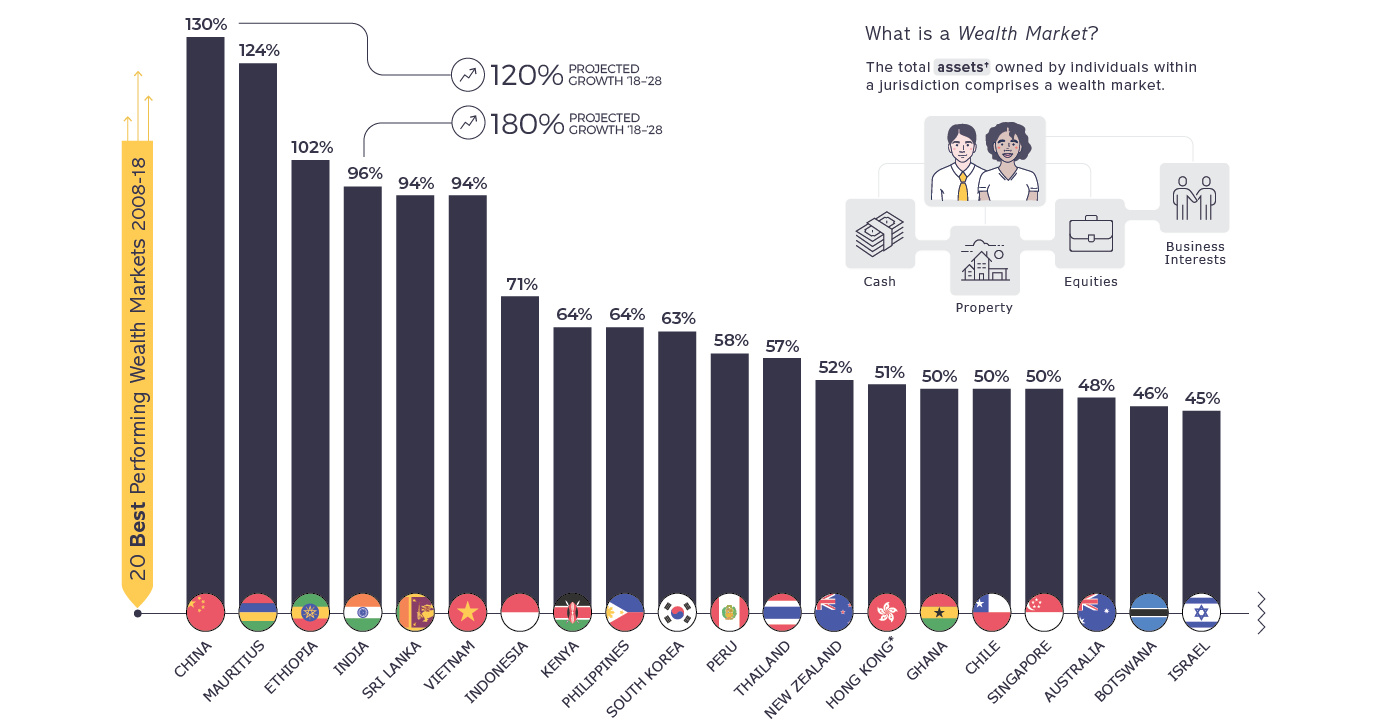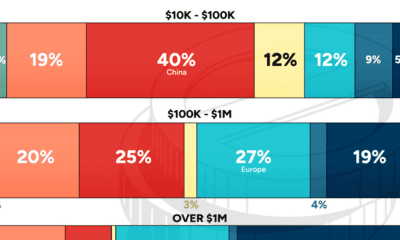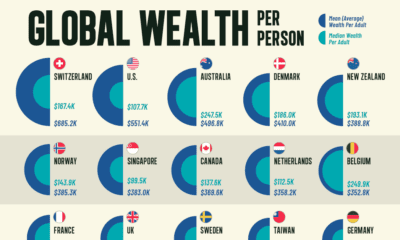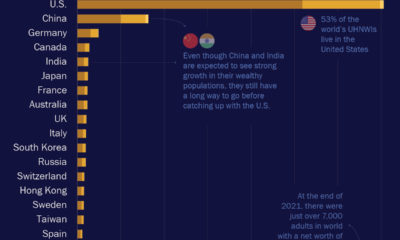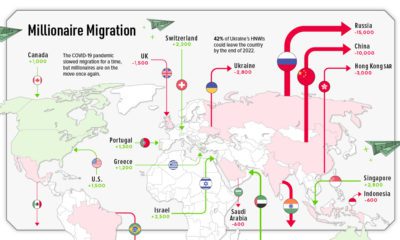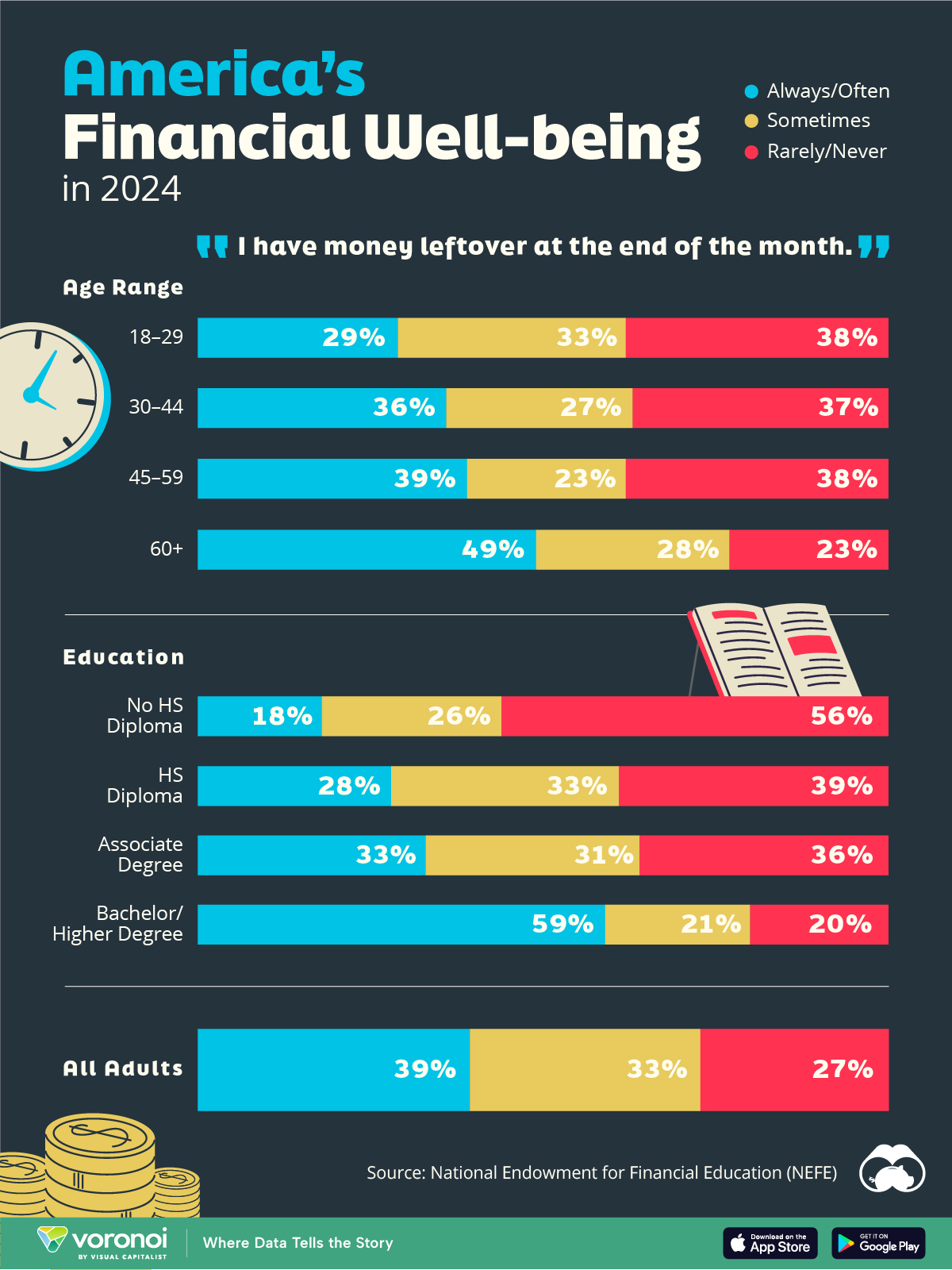Money
The Best and Worst Performing Wealth Markets in the Last 10 Years
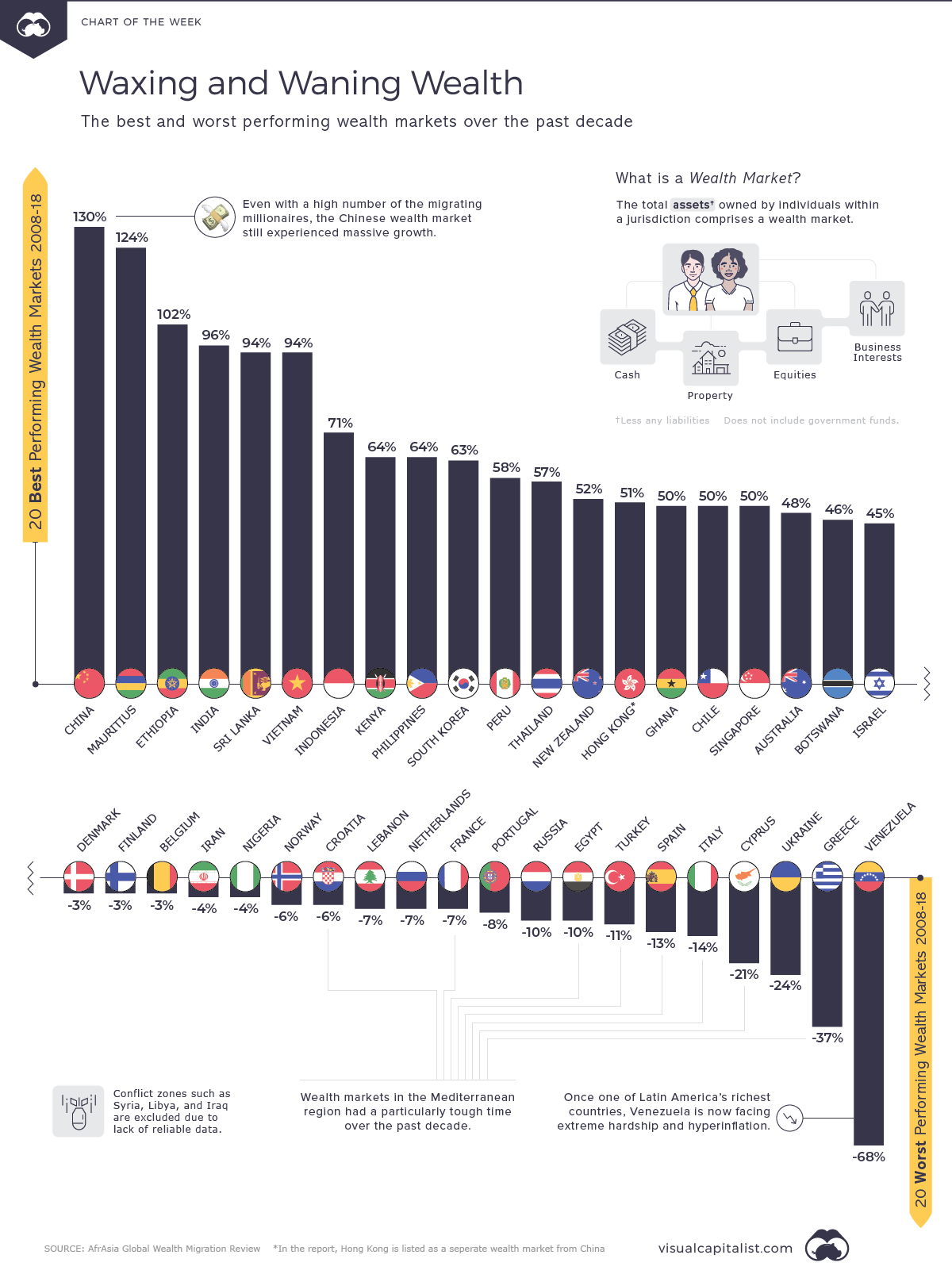
The Best and Worst Performing Wealth Markets
A lot can change in a decade.
Ten years ago, the collapse of Lehman Brothers sent the world’s financial markets into a tailspin, a catalyst for years of economic uncertainty.
At the same time, China’s robust GDP growth was reaching a fever pitch. The country was turning into a wealth creation machine, creating millions of newly-minted millionaires who would end up having a huge impact on wealth markets around the world.
The Ups and Downs of Wealth Markets (2008-2018)
Today’s graphic, using data from the Global Wealth Migration Review, looks at national wealth markets, and how they’ve changed since 2008.
Each wealth market is calculated from the sum of individual assets within the jurisdiction, accounting for the value of cash, property, equity, and business interests owned by people in the country. Just like other kinds of markets, wealth can grow or shrink over time.
Here are a few countries and regions that stand out in the report:
Developing Asian Economies
In terms of sheer wealth growth, nothing comes close to countries like China and India. The size of these markets, combined with rapid economic growth, have resulted in triple-digit gains over the last 10 years.
For the world’s two most populous countries, it’s a trend that is expected to continue into the next decade, despite the fact that many millionaire residents are migrating to different jurisdictions.
Mediterranean Malaise
European nations saw very little growth over the past decade, but the Mediterranean region was particularly hard-hit. In fact, eight of the 20 worst performing wealth markets over the last decade are located along the Mediterranean coast:
| Rank (Out of 90) | Country | % Growth (2008-2018) |
|---|---|---|
| 89 | 🇬🇷 Greece | -37% |
| 87 | 🇨🇾 Cyprus | -21% |
| 86 | 🇮🇹 Italy | -14% |
| 85 | 🇪🇸 Spain | -13% |
| 84 | 🇹🇷 Turkey | -11% |
| 82 | 🇪🇬 Egypt | -10% |
| 80 | 🇫🇷 France | -7% |
| 76 | 🇭🇷 Croatia | -6% |
European Bright Spots
There were some bright spots in Europe during this same time period. Malta, Ireland, and Monaco all achieved positive wealth growth at rates higher than 30% over the last 10 years.
Australia
While it’s expected to see rapidly-growing economies as prolific producers of wealth, it is much more surprising when mature markets perform so strongly. Singapore and New Zealand fall under that category, as does Australia, which was already a large, mature wealth market.
Australia recently surpassed both Canada and France to become the seventh largest wealth market in the world, and last year alone, over 12,000 millionaires migrated there.
Venezuela
The long-term economic slide of Venezuela has been well documented, and it comes as no surprise that the country saw extreme contraction of wealth over the last decade. Since war-torn countries are not included in the report, Venezuela ranked 90th, which is dead-last on a global basis.
Short Term, Long Term
In 2018, global wealth actually slumped by 5%, dropping from $215 trillion to $204 trillion.
All 90 countries tracked by the report experienced negative growth in wealth, as global stock and property markets dipped. Here’s a look at the wealth markets that were the hardest hit over the past year:
| Wealth Market | Wealth growth (2017 -2018) |
|---|---|
| 🇻🇪 Venezuela | -25% |
| 🇹🇷 Turkey | -23% |
| 🇦🇷 Argentina | -20% |
| 🇵🇰 Pakistan | -15% |
| 🇦🇴 Angola | -15% |
| 🇺🇦 Ukraine | -13% |
| 🇫🇷 France | -12% |
| 🇷🇺 Russia | -12% |
| 🇮🇷 Iran | -12% |
| 🇶🇦 Qatar | -12% |
The future outlook is rosier. Global wealth is expected to rise by 43% over the next decade, reaching $291 trillion by 2028. If current trends play out as expected, Vietnam could likely top this list a decade from now with a staggering 200% growth rate.
Money
Charted: Who Has Savings in This Economy?
Older, better-educated adults are winning the savings game, reveals a January survey by the National Opinion Research Center at the University of Chicago.
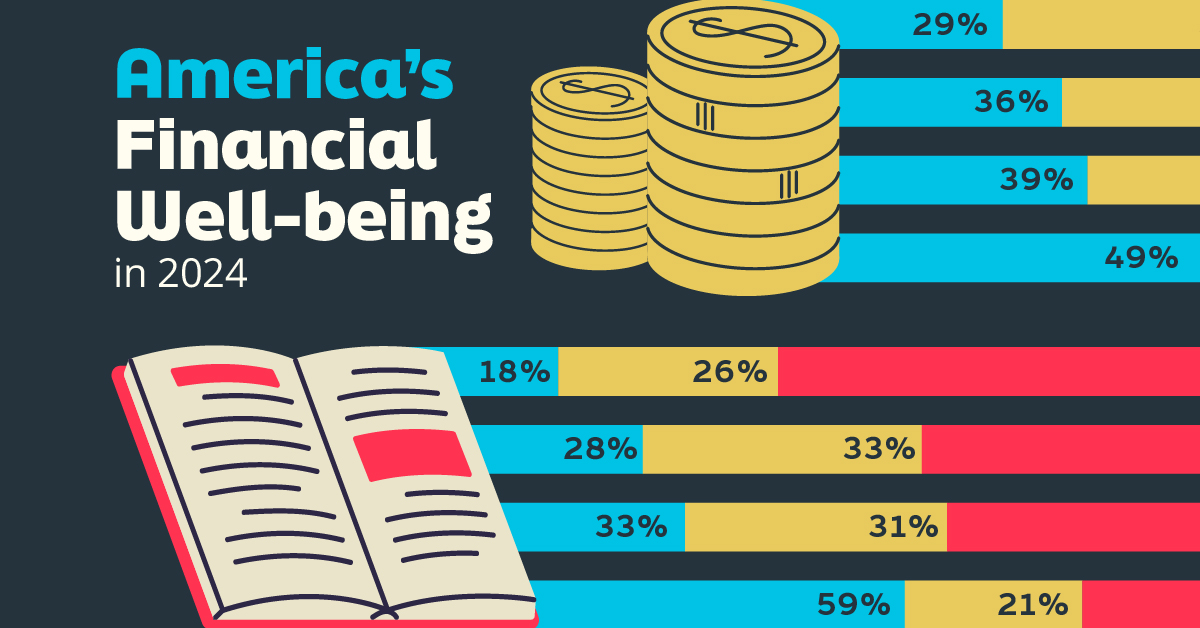
Who Has Savings in This Economy?
This was originally posted on our Voronoi app. Download the app for free on iOS or Android and discover incredible data-driven charts from a variety of trusted sources.
Two full years of inflation have taken their toll on American households. In 2023, the country’s collective credit card debt crossed $1 trillion for the first time. So who is managing to save money in the current economic environment?
We visualize the percentage of respondents to the statement “I have money leftover at the end of the month” categorized by age and education qualifications. Data is sourced from a National Endowment for Financial Education (NEFE) report, published last month.
The survey for NEFE was conducted from January 12-14, 2024, by the National Opinion Research Center at the University of Chicago. It involved 1,222 adults aged 18+ and aimed to be representative of the U.S. population.
Older Americans Save More Than Their Younger Counterparts
General trends from this dataset indicate that as respondents get older, a higher percentage of them are able to save.
| Age | Always/Often | Sometimes | Rarely/Never |
|---|---|---|---|
| 18–29 | 29% | 33% | 38% |
| 30–44 | 36% | 27% | 37% |
| 45–59 | 39% | 23% | 38% |
| Above 60 | 49% | 28% | 23% |
| All Adults | 39% | 33% | 27% |
Note: Percentages are rounded and may not sum to 100.
Perhaps not surprisingly, those aged 60+ are the age group with the highest percentage saying they have leftover money at the end of the month. This age group spent the most time making peak earnings in their careers, are more likely to have investments, and are more likely to have paid off major expenses like a mortgage or raising a family.
The Impact of Higher Education on Earnings and Savings
Based on this survey, higher education dramatically improves one’s ability to save. Shown in the table below, those with a bachelor’s degree or higher are three times more likely to have leftover money than those without a high school diploma.
| Education | Always/Often | Sometimes | Rarely/Never |
|---|---|---|---|
| No HS Diploma | 18% | 26% | 56% |
| HS Diploma | 28% | 33% | 39% |
| Associate Degree | 33% | 31% | 36% |
| Bachelor/Higher Degree | 59% | 21% | 20% |
| All Adults | 39% | 33% | 27% |
Note: Percentages are rounded and may not sum to 100.
As the Bureau of Labor Statistics notes, earnings improve with every level of education completed.
For example, those with a high school diploma made 25% more than those without in 2022. And as the qualifications increase, the effects keep stacking.
Meanwhile, a Federal Reserve study also found that those with more education tended to make financial decisions that contributed to building wealth, of which the first step is to save.
-

 Markets1 week ago
Markets1 week agoU.S. Debt Interest Payments Reach $1 Trillion
-

 Markets2 weeks ago
Markets2 weeks agoRanked: The Most Valuable Housing Markets in America
-

 Money2 weeks ago
Money2 weeks agoWhich States Have the Highest Minimum Wage in America?
-

 AI2 weeks ago
AI2 weeks agoRanked: Semiconductor Companies by Industry Revenue Share
-

 Markets2 weeks ago
Markets2 weeks agoRanked: The World’s Top Flight Routes, by Revenue
-

 Countries2 weeks ago
Countries2 weeks agoPopulation Projections: The World’s 6 Largest Countries in 2075
-

 Markets2 weeks ago
Markets2 weeks agoThe Top 10 States by Real GDP Growth in 2023
-

 Money2 weeks ago
Money2 weeks agoThe Smallest Gender Wage Gaps in OECD Countries

